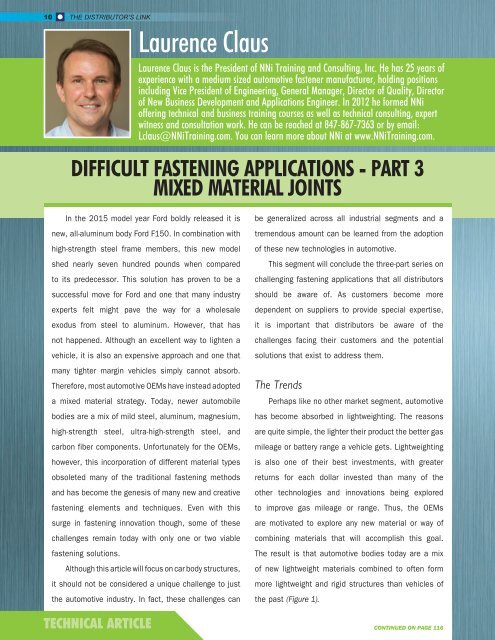FALL 2023
Distributor's Link Magazine Fall 2023 / Vol 46 No 4
Distributor's Link Magazine Fall 2023 / Vol 46 No 4
You also want an ePaper? Increase the reach of your titles
YUMPU automatically turns print PDFs into web optimized ePapers that Google loves.
10<br />
THE DISTRIBUTOR’S LINK<br />
Laurence Claus<br />
Laurence Claus is the President of NNi Training and Consulting, Inc. He has 25 years of<br />
experience with a medium sized automotive fastener manufacturer, holding positions<br />
including Vice President of Engineering, General Manager, Director of Quality, Director<br />
of New Business Development and Applications Engineer. In 2012 he formed NNi<br />
offering technical and business training courses as well as technical consulting, expert<br />
witness and consultation work. He can be reached at 847-867-7363 or by email:<br />
Lclaus@NNiTraining.com. You can learn more about NNi at www.NNiTraining.com.<br />
DIFFICULT FASTENING APPLICATIONS - PART 3<br />
MIXED MATERIAL JOINTS<br />
In the 2015 model year Ford boldly released it is<br />
new, all-aluminum body Ford F150. In combination with<br />
high-strength steel frame members, this new model<br />
shed nearly seven hundred pounds when compared<br />
to its predecessor. This solution has proven to be a<br />
successful move for Ford and one that many industry<br />
experts felt might pave the way for a wholesale<br />
exodus from steel to aluminum. However, that has<br />
not happened. Although an excellent way to lighten a<br />
vehicle, it is also an expensive approach and one that<br />
many tighter margin vehicles simply cannot absorb.<br />
Therefore, most automotive OEMs have instead adopted<br />
a mixed material strategy. Today, newer automobile<br />
bodies are a mix of mild steel, aluminum, magnesium,<br />
high-strength steel, ultra-high-strength steel, and<br />
carbon fiber components. Unfortunately for the OEMs,<br />
however, this incorporation of different material types<br />
obsoleted many of the traditional fastening methods<br />
and has become the genesis of many new and creative<br />
fastening elements and techniques. Even with this<br />
surge in fastening innovation though, some of these<br />
challenges remain today with only one or two viable<br />
fastening solutions.<br />
Although this article will focus on car body structures,<br />
it should not be considered a unique challenge to just<br />
the automotive industry. In fact, these challenges can<br />
TECHNICAL ARTICLE<br />
be generalized across all industrial segments and a<br />
tremendous amount can be learned from the adoption<br />
of these new technologies in automotive.<br />
This segment will conclude the three-part series on<br />
challenging fastening applications that all distributors<br />
should be aware of. As customers become more<br />
dependent on suppliers to provide special expertise,<br />
it is important that distributors be aware of the<br />
challenges facing their customers and the potential<br />
solutions that exist to address them.<br />
The Trends<br />
Perhaps like no other market segment, automotive<br />
has become absorbed in lightweighting. The reasons<br />
are quite simple, the lighter their product the better gas<br />
mileage or battery range a vehicle gets. Lightweighting<br />
is also one of their best investments, with greater<br />
returns for each dollar invested than many of the<br />
other technologies and innovations being explored<br />
to improve gas mileage or range. Thus, the OEMs<br />
are motivated to explore any new material or way of<br />
combining materials that will accomplish this goal.<br />
The result is that automotive bodies today are a mix<br />
of new lightweight materials combined to often form<br />
more lightweight and rigid structures than vehicles of<br />
the past (Figure 1).<br />
CONTINUED ON PAGE 116
















